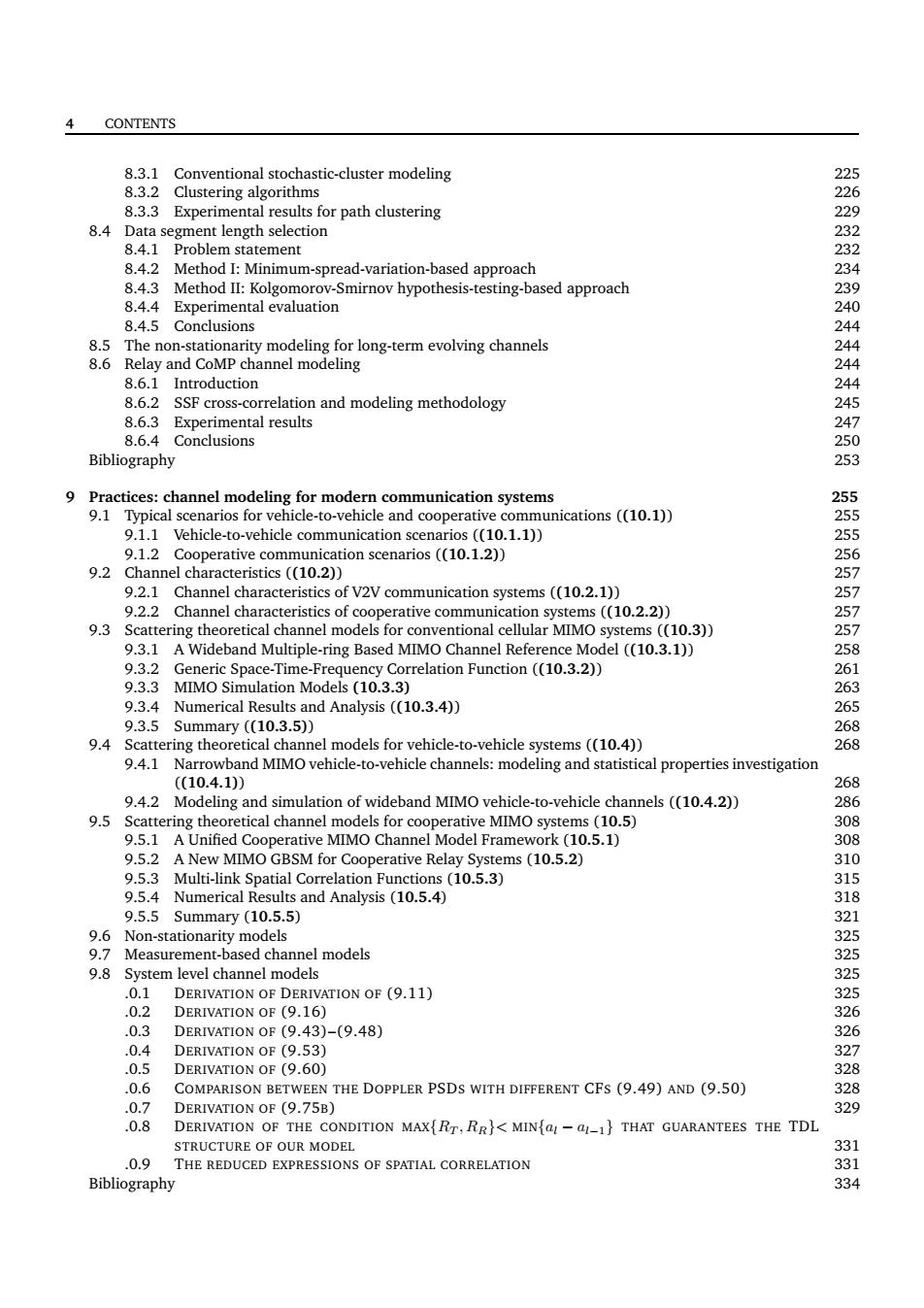正在加载图片...

4 CONTENTS C&aneniganaaiasicdhstermodeimg 8.3.3 Experimental results for path clustering 8.4 84.2 Method I:Minimum-spread-variation-based approach 8.4.3 Method I:Kolgomorov-Smirnov hypothesis-testing-based approach 4.5 talevaluation 8.5 The non-station ity modeling for long-term evolving channels 8.6 elay and CoMP channel modeling 862 SSE CrO rrelation and modeling methodology 8.6.3 Experimental results 8.6. Conclusion ices:channel modein mmunication systems 9.1.1 Vehicle-to-vehicle communication scenarios ((10.1.1)) ications((10.1)) 9.1.2 9.2 Cooperative communication scenarios((10.1.2)) 92 ((10.2) (10.2113 9.2.2 channel chara eristics of coo erative communicat tion systems((10.2.2)) 5555 9.3 nel models for entional cellular MIMC .2 Generic Space rrelation Function 93 MIMO Simulation Models(10.3.3) 9.35 Numerical 10.3 nd Analysis ((10.3.4)) 9.Scattering theoretical channel models for vehicle-to-vehicle systems((10.)) 9.4.1 nd MIMO vehicle-to-vehicle channels:modeling and statistical properties investigation 9.4.2 Modeling and simulation of wideband MIMO vehicle-to-vehicle channels ((10.4.2)) 9.5 052 A IMO Channe .5.1 53 Multi-link Spatial Corr relation Functions (10..) 93 Summ Measurement-based channel models 325 9.8 models 0. DERIVATION OF(9.43)-(9.48) .0.6 COMPARISON BETWEEN THE DOPPLER PSDS WITH DIFFERENT CFS (9.49)AND(9.50) 328 DERIVATION OF (9.75B) 329 ITION MAX{RT,RR)<MIN(aI-a-1)THAT GUARANTEES THE TDL 3 0.9 THE REDUCED EXPRESSIONS OF SPATIAL CORRELATION Bibliography 344 CONTENTS 8.3.1 Conventional stochastic-cluster modeling 225 8.3.2 Clustering algorithms 226 8.3.3 Experimental results for path clustering 229 8.4 Data segment length selection 232 8.4.1 Problem statement 232 8.4.2 Method I: Minimum-spread-variation-based approach 234 8.4.3 Method II: Kolgomorov-Smirnov hypothesis-testing-based approach 239 8.4.4 Experimental evaluation 240 8.4.5 Conclusions 244 8.5 The non-stationarity modeling for long-term evolving channels 244 8.6 Relay and CoMP channel modeling 244 8.6.1 Introduction 244 8.6.2 SSF cross-correlation and modeling methodology 245 8.6.3 Experimental results 247 8.6.4 Conclusions 250 Bibliography 253 9 Practices: channel modeling for modern communication systems 255 9.1 Typical scenarios for vehicle-to-vehicle and cooperative communications ((10.1)) 255 9.1.1 Vehicle-to-vehicle communication scenarios ((10.1.1)) 255 9.1.2 Cooperative communication scenarios ((10.1.2)) 256 9.2 Channel characteristics ((10.2)) 257 9.2.1 Channel characteristics of V2V communication systems ((10.2.1)) 257 9.2.2 Channel characteristics of cooperative communication systems ((10.2.2)) 257 9.3 Scattering theoretical channel models for conventional cellular MIMO systems ((10.3)) 257 9.3.1 A Wideband Multiple-ring Based MIMO Channel Reference Model ((10.3.1)) 258 9.3.2 Generic Space-Time-Frequency Correlation Function ((10.3.2)) 261 9.3.3 MIMO Simulation Models (10.3.3) 263 9.3.4 Numerical Results and Analysis ((10.3.4)) 265 9.3.5 Summary ((10.3.5)) 268 9.4 Scattering theoretical channel models for vehicle-to-vehicle systems ((10.4)) 268 9.4.1 Narrowband MIMO vehicle-to-vehicle channels: modeling and statistical properties investigation ((10.4.1)) 268 9.4.2 Modeling and simulation of wideband MIMO vehicle-to-vehicle channels ((10.4.2)) 286 9.5 Scattering theoretical channel models for cooperative MIMO systems (10.5) 308 9.5.1 A Unified Cooperative MIMO Channel Model Framework (10.5.1) 308 9.5.2 A New MIMO GBSM for Cooperative Relay Systems (10.5.2) 310 9.5.3 Multi-link Spatial Correlation Functions (10.5.3) 315 9.5.4 Numerical Results and Analysis (10.5.4) 318 9.5.5 Summary (10.5.5) 321 9.6 Non-stationarity models 325 9.7 Measurement-based channel models 325 9.8 System level channel models 325 .0.1 DERIVATION OF DERIVATION OF (9.11) 325 .0.2 DERIVATION OF (9.16) 326 .0.3 DERIVATION OF (9.43)–(9.48) 326 .0.4 DERIVATION OF (9.53) 327 .0.5 DERIVATION OF (9.60) 328 .0.6 COMPARISON BETWEEN THE DOPPLER PSDS WITH DIFFERENT CFS (9.49) AND (9.50) 328 .0.7 DERIVATION OF (9.75B) 329 .0.8 DERIVATION OF THE CONDITION MAX{RT , RR}< MIN{al − al−1} THAT GUARANTEES THE TDL STRUCTURE OF OUR MODEL 331 .0.9 THE REDUCED EXPRESSIONS OF SPATIAL CORRELATION 331 Bibliography 334